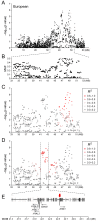Genome-Wide Association Study of Golden Retrievers Identifies Germ-Line Risk Factors Predisposing to Mast Cell Tumours
- PMID: 26588071
- PMCID: PMC4654484
- DOI: 10.1371/journal.pgen.1005647
Genome-Wide Association Study of Golden Retrievers Identifies Germ-Line Risk Factors Predisposing to Mast Cell Tumours
Abstract
Canine mast cell tumours (CMCT) are one of the most common skin tumours in dogs with a major impact on canine health. Certain breeds have a higher risk of developing mast cell tumours, suggesting that underlying predisposing germ-line genetic factors play a role in the development of this disease. The genetic risk factors are largely unknown, although somatic mutations in the oncogene C-KIT have been detected in a proportion of CMCT, making CMCT a comparative model for mastocytosis in humans where C-KIT mutations are frequent. We have performed a genome wide association study in golden retrievers from two continents and identified separate regions in the genome associated with risk of CMCT in the two populations. Sequence capture of associated regions and subsequent fine mapping in a larger cohort of dogs identified a SNP associated with development of CMCT in the GNAI2 gene (p = 2.2x10-16), introducing an alternative splice form of this gene resulting in a truncated protein. In addition, disease associated haplotypes harbouring the hyaluronidase genes HYAL1, HYAL2 and HYAL3 on cfa20 and HYAL4, SPAM1 and HYALP1 on cfa14 were identified as separate risk factors in European and US golden retrievers, respectively, suggesting that turnover of hyaluronan plays an important role in the development of CMCT.
Conflict of interest statement
A patent application has been filed related to this work patent application number B1195.70019US00.
Figures





References
-
- Molderings GJ (2014) The genetic basis of mast cell activation disease—looking through a glass darkly. Crit Rev Oncol Hematol. - PubMed
-
- Laine E, Chauvot de Beauchene I, Perahia D, Auclair C, Tchertanov L (2011) Mutation D816V alters the internal structure and dynamics of c-KIT receptor cytoplasmic region: implications for dimerization and activation mechanisms. PLoS Comput Biol 7: e1002068 10.1371/journal.pcbi.1002068 - DOI - PMC - PubMed
Publication types
MeSH terms
Substances
Grants and funding
LinkOut - more resources
Full Text Sources
Other Literature Sources
Miscellaneous

